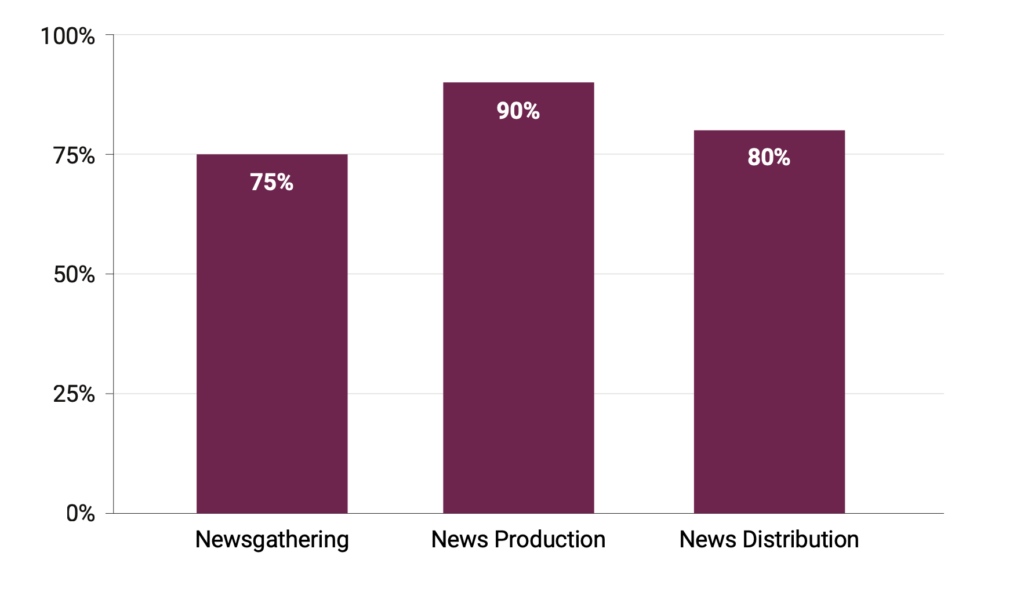How can smaller, independent publishers and media organisations experiment with AI? The focus of most articles is on large scale, big media with extensive in-house tech teams. What are the opportunities for smaller scale experimentation to save time, and up-skill your teams?
The image above is from the JournalismAI report that surveyed 100 newsrooms. The overwhelming majority are using AI for content gathering, production and distribution, so maybe independent publishers need to explore AI as well.
This article is my round up of down to earth, practical examples of how to start the process of testing out AI in your independent media business.
Effective news gathering and research
Editorial teams can save time researching and drafting in-depth reports and articles by using a range of different tools.
- Spotting trending topics – Journalists are using tools like CrowdTangle, Dataminr, Rapidminr to spot viral stories on social media that are worth investigating.
- Researching articles – ChatGPT can be used to review other news sources and identify reputable sources for a new story. This article by RISJ shows that it saves time but is not 100% comprehensive or reliable. Pinpoint is a Google tool that allows journalists to quickly search PDFs, images and audio files in their research set.
- Fact checking – Full Fact provides AI enabled software for fact checking.
- Speech to text – transcription tools for converting audio to text include Otter, Trint or Good Tape.
Efficient content production
Audiences now demand content in multiple formats and tailored for different platforms. But much of this processing can be automated.
- Summarisation – Many publishers are using summarisation tools for longer articles. Schibsted discovered that people spent more time reading articles that had summaries.
- Headline writing – ChatGPT is effective at suggesting a range of headlines for an article
- Synthetic voice for audio – Journalists are using voicebots to convert text stories to audio. One European publisher added audio to all its articles using synthetic voice – which proved popular with readers. Amazon Polly was an early provider of text to speech.
- Image generation – Midjourney has been used by designers to create original graphics for articles, although there is a skill in crafting the right prompts. Bing Image Creator powered by DALL E3 is free to test.
- Reformatting content for social media – using ChatGPT
- Proofreading – using Grammarly, ProWriting Aid, Copysmith
- Translation – Metro World News used ChatGPT to translate articles from Spanish to Brazilian Portuguese, reducing time per article from 20-40 min to 5 min and growing pageviews and session time – read more
- Video or slideshow creation using tools like Stable diffusion. Good example of an AI-created video from David Caswell here.
Content distribution, UX, marketing
Marketers can feel swamped by all the copy they have to create and all the channels they need to access to distribute content. But AI tools can remove some of the drudgery.
- SEO – suggest headlines with Generative AI. Use tools like Copysmith to create SEO friendly copy. Ubersuggest can be used to identify popular keywords.
- Automated tagging – may be included in your CMS
- Social media distribution – use tools like Echobox and Social flow to optimise content scheduling
- Personalisation & content recommendation – Google and Amazon provide recommendation tools, and Crux has worked with B2B publisher Sifted.eu.
- Marketing email drafting – can use ChatGPT
- Comment moderation – Perspective API by Jigsaw has been used by El Pais to moderate comments. https://www.perspectiveapi.com/
Internal productivity
- Internal meeting summaries – Zoom now includes an AI summary in its standard paid package – that generates a reasonable summary of a zoom meeting. It’s not good enough to publish, but useful for internal.
- Sales letters – can use Chat GPT
Ethical issues
Always keep a human in the loop. Generative AI is still prone to hallucination (aka making up facts) so cannot be used by reputable publishers without human intervention. And AI generated summaries will probably require a human editor. But the tools do save time in the process.
Transparency with audiences is key – eg the FT has publicly stated that it won’t publish stories written by AI, although they use AI in production.
Skills development
It is essential to up-skill current teams by enabling experimentation, and free courses from Google or Journalism AI (links below). However, open-mindedness and entrepreneurial spirit are as important as technical knowledge. Some specific skills, such as data analysts, may need to be hired in.
How to get started with AI as an independent publisher
In independent and smaller media businesses, it’s worth encouraging all teams (editorial, sales, marketing, tech) to experiment with AI and document what works and what doesn’t, to build up company knowledge and also develop individual skills in using AI tools.
Journalism AI starter pack has lots of practical examples.
Journalism AI ran an Academy for small newsrooms in 2023 – applications closed for this year but worth tracking for the future.
Google news initiative offer a range of free courses
Not everything will work, so start with small experiments, and share your successes (and cautionary tales) with other indie media businesses.
One place to start could be the Speciall Media Group, a community of over 250 publishers which I run on Guild. It’s free (for now) but invite only.
You might also like this recent article on AI.
About the author
Carolyn Morgan has acquired, launched, built, and sold specialist media businesses in print, digital and events. She now advises niche consumer and B2B publishers on developing new products and digital revenue streams as a consultant and NED.
Find out more about the advice we provide for publishers

